Astronomy:List of lunar deities
From HandWiki
Short description: None
A lunar deity is a deity who represents the Moon, or an aspect of it. Lunar deities and Moon worship can be found throughout most of recorded history in various forms. The following is a list of lunar deities:
African
| Name | Image | Mythology / Religion | Details |
|---|---|---|---|
| Abuk | Dinka | Goddess of fertility, morality, creativity, and love | |
| Amesemi | Kushite | Protective goddess and wife of Apedemak, the lion-god. She was represented with a crown shaped as a falcon, or with a crescent moon on her head on top of which a falcon was standing. | |
| Ayyur | Berber | ||
| Gleti | Dahomean | ||
| Mawu | Dahomean | ||
| Iah | Egyptian | ||
| iNyanga | Zulu | Goddess of the Moon | |
| Khonsu | 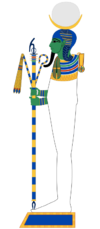 |
Egyptian | The god of the moon. A story tells that Ra (the sun God) had forbidden Nut (the Sky goddess) to give birth on any of the 360 days of the calendar. In order to help her give birth to her children, Thoth (the god of wisdom) played against Khonsu in a game of senet. Khonsu lost to Thoth and then he gave away enough moonlight to create 5 additional days so Nut could give birth to her five children. It was said that before losing, the moonlight was on par with the sunlight. Sometimes, Khonsu is depicted as a hawk-headed god, however he is mostly depicted as a young man with a side-lock of hair, like a young Egyptian. He was also a god of time. The centre of his cult was at Thebes which was where he took place in a triad with Amun and Mut. Khonsu was also heavily associated Thoth who also took part in the measurement of time and the moon. |
| Thoth | Egyptian | God of wisdom, the arts, science, and judgment | |
| Ela-Opitan | Yoruba |
American
Aztec mythology
- Deity Metztli
- Goddess Coyolxauhqui
- God Tecciztecatl
Cahuilla mythology
- Goddess Menily[1]
Incan mythology
- Goddess Mama Killa
- Goddess Ka-Ata-Killa
- God Coniraya
Inuit mythology
- God Alignak
- God Igaluk
- God Tarqiup Inua
Lakota mythology
- Goddess Awilix; Xbalanque was their mortal (male) incarnation
- Maya moon goddess
Muisca mythology
- Goddess Huitaca
- Goddess Chía
Nivaclé Mythology
- Jive'cla
Pawnee mythology
Tupi Guarani mythology
- God Abaangui
- Goddess Arasy
- God/Goddess Jaci (gender depends on tribe)
Voodoo
- God Kalfu
Asian
Ainu mythology
- God Kunnechup Kamui
Anatolian
Chinese mythology
- Jie Lin, God that carries the Moon across the night sky [2]
- Chang Xi Mother of twelve moons corresponding to the twelve months of the year
- Chang'e Immortal that lives on the Moon
- Tai yin xing jun (太陰星君; Tàiyīn xīng jūn) of Investiture of the Gods in taoism and Chinese folk religion[3][4]
- Tu'er Ye Rabbit god that lives on the Moon
- Wu Gang Immortal that lives on the Moon
Elamite
- God Napir

- God Agni, invoked as a moon deity in some hymns[5]
- God Chandra or Soma, The moon god
- God Kušuḫ (Hurrian mythology)
- Goddess Selardi (Urartian mythology)
Indonesian mythology
- Goddess Ratih
- Goddess Silewe Nazarate
Japanese mythology
- God Tsukuyomi
Korean mythology
- Goddess Myeongwol[6]
Mari mythology
- God Tõlze
Philippine mythologies
- Kabigat (Bontok mythology): the goddess of the moon who cut off the head of Chal-chal's son; her action is the origin of headhunting[7]
- Bulan (Ifugao mythology): the moon deity of the night in charge of nighttime[8]
- Moon Deity (Ibaloi mythology): the deity who teased Kabunian for not yet having a spouse[9]
- Delan (Bugkalot mythology): deity of the moon, worshiped with the sun and stars; congenial with Elag; during quarrels, Elag sometimes covers Delan's face, causing the different phases of the moon; giver of light and growth[10]
- Bulan (Ilocano mythology): the moon god of peace who comforted the grieving Abra[11]
- Bulan (Pangasinense mythology): the merry and mischievous moon god, whose dim palace was the source of the perpetual light which became the stars; guides the ways of thieves[12]
- Wife of Mangetchay (Kapampangan mythology): wife of Mangetchay who gave birth to their daughter whose beauty sparked the great war; lives in the Moon[13]
- Mayari (Kapampangan mythology): the moon goddess who battled her brother, Apolaqui[14]
- Apûng Malyari (Kapampangan mythology): moon god who lives in Mount Pinatubo and ruler of the eight rivers[15]
- Mayari (Tagalog mythology): goddess of the moon;[16] sometimes identified as having one eye;[17] ruler of the world during nighttime and daughter of Bathala[18]
- Dalagang nasa Buwan (Tagalog mythology): the maiden of the moon[19]
- Dalagang Binubukot (Tagalog mythology): the cloistered maiden in the moon[20]
- Unnamed Moon God (Tagalog mythology): the night watchman who tattled on Rajo's theft, leading to an eclipse[21]
- Bulan-hari (Tagalog mythology): one of the deities sent by Bathala to aid the people of Pinak; can command rain to fall; married to Bitu-in[22]
- Bulan (Bicolano mythology): son of Dagat and Paros; joined Daga's rebellion and died; his body became the Moon;[23] in another myth, he was alive and from his cut arm, the earth was established, and from his tears, the rivers and seas were established[24]
- Haliya (Bicolano mythology): the goddess of the moon,[25] often depicted with a golden mask on her face
- Libulan (Bisaya mythology): the copper-bodied son of Lidagat and Lihangin; killed by Kaptan's rage during the great revolt; his body became the moon[26]
- Bulan (Bisaya mythology): the moon deity who gives light to sinners and guides them in the night[27]
- Launsina (Capiznon mythology): the goddess of the Sun, Moon, stars, and seas, and the most beloved because people seek forgiveness from her[28]
- Diwata na Magbabaya (Bukidnon mythology): simply referred as Magbabaya; the good supreme deity and supreme planner who looks like a man; created the Earth and the first eight elements, namely bronze, gold, coins, rock, clouds, rain, iron, and water; using the elements, he also created the sea, sky, Moon, and stars; also known as the pure god who wills all things; one of three deities living in the realm called Banting[29]
- Bulon La Mogoaw (T'boli mythology): one of the two supreme deities; married to Kadaw La Sambad; lives in the seventh layer of the universe[30]
- Moon Deity (Maranao mythology): divine being depicted in an anthropomorphic form as a beautiful young woman; angels serve as her charioteers[31]
Vietnamese mythology
- Goddess Thần Mặt Trăng, the embodiment of the moon, the daughter of Ông Trời
- Goddess Hằng Nga, goddess who lives on the moon
Semitic mythology
- God Aglibol (Palmarene mythology)
- God Almaqah (Sabaean mythology)
- God Baal-hamon (Punic religion)
- God Saggar (Eblaite religion)
- God Sin (Mesopotamian mythology)
- God Ta'lab (Arabian mythology)
- God Wadd (Minaean mythology)
- God Yarikh (Amorite and Ugaritic mythology)
- God Ay Ata
European
| Name | Image | Mythology / Religion | Details |
|---|---|---|---|
| Arianrhod[citation needed] | Welsh | ||
| Artemis | 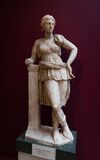 |
Greek | Artemis is the ancient Greek goddess of the hunt, wilderness, wild animals, chastity, and occasionally the Moon due to being mistaken for Selene.[32][33] She is the daughter of Zeus and Leto and the twin sister of Apollo.[34] She would eventually be extensively syncretized with the Roman goddess Diana. Cynthia was originally an epithet of the Greek goddess Artemis, who according to legend was born on Mount Cynthus. Selene, the Greek personification of the Moon, and the Roman Diana were also sometimes called "Cynthia".[35] |
| Artume | Etruscan | ||
| Ataegina | 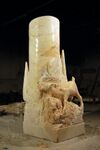 |
Lusitanian | |
| Sen | Mesopotamian Religion | ||
| Bendis | 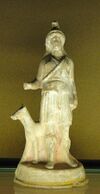 |
Thracian | |
| Devana | Slavic | Devana was the Slavic goddess of wild nature, forests, hunting and the moon, equated with the Greek goddess Artemis and Roman goddess Diana. | |
| Diana |  |
Roman | Diana is a goddess in Roman and Hellenistic religion, primarily considered a patroness of the countryside, hunters, crossroads, and the Moon. She is equated with the Greek goddess Artemis (see above), and absorbed much of Artemis' and Selenes mythology early in Roman history, including a birth on the island of Delos to parents Jupiter and Latona, and a twin brother, Apollo,[36] though she had an independent origin in Italy. |
| Elatha[citation needed] | Irish | Elatha was a king of the Fomorians in Irish mythology. He succeeded his father Delbáeth and was replaced by his son Bres, mothered by Ériu. | |
| Hecate | Greek | While associated with the Moon, Hecate is not actually considered a goddess of the moon. | |
| Hors | Slavic | ||
| Hjúki and Bil | Norse | ||
| Ilargi | Basque | ||
| Kuu | Finnish | ||
| Losna | Etruscan | ||
| Luna | 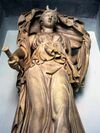 |
Roman | Roman counterpart to the Greek Titaness Selene. Sibling to Sol and Aurora. Considered one of the 20 principal deities of Rome, having had temples on both the Aventine and Palatine hills. |
| Mano | Sámi | ||
| Máni | 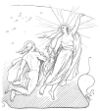 |
Norse | Máni is the personification of the Moon in Norse mythology. Máni, personified, is attested in the Poetic Edda, compiled in the 13th century from earlier traditional sources, and the Prose Edda, written in the 13th century by Snorri Sturluson. Both sources state that he is the brother of the personified sun, Sól, and the son of Mundilfari, while the Prose Edda adds that he is followed by the children Hjúki and Bil through the heavens. |
| Mehnot | Proto-Indo-European mythology | ||
| Meness | Latvian | ||
| Myesyats | Slavic | ||
| Phoebe | Greek | ||
| Selene |  |
Greek | Selene Titan goddess and personification of the moon. She was depicted as a woman riding sidesaddle on a horse or driving a chariot drawn by a pair of winged steeds. |
| Triple Goddess |  |
Wicca |
Oceanic
Malagasy mythology
- God Andriambahomanana
Polynesian mythology
- God Avatea
- God Fati
- Goddess Hina
- Goddess Mahina
- God Marama
Australian Aboriginal mythology
- God Bahloo
Mandjindja mythology
- God Kidili
Yolŋu mythology
- God Ngalindi
See also
- Allah as a lunar deity
- List of solar deities
- Man in the Moon
- Moon idol, a type of firedog
- Moon rabbit
- Nature worship
- Solar deity
- Worship of heavenly bodies
References
- ↑ "Menily, the Cahuilla moon goddess (Menilly, Menil, Man-El)". http://www.native-languages.org/morelegends/menily.htm.
- ↑ 太上洞真五星秘授经
- ↑ Overmyer, Daniel L. (1986). Religions of China: The World as a Living System. New York: Harper & Row. p. 51. ISBN 9781478609896. https://books.google.com/books?id=nYkbAAAAQBAJ.
- ↑ Fan, Chen 2013. p. 23
- ↑ Dexter, Miriam Robbins. Whence the goddesses: a source book. The Athene Series. New York and London: Teachers College Press, Teachers College, Columbia University. 1990. p. 154. ISBN 0-8077-6234-2.
- ↑ Seo, Dae Seok. "Song of Sun and Moon". https://folkency.nfm.go.kr/en/topic/detail/5390.
- ↑ Jenks, A. (1905). The Bontoc Igorot. Manila: Bureau of Printing.
- ↑ Bimmolog, H., Sallong, L., Montemayor, L. (2005). The Deities of the Animistic Religion of Mayaoyao, Ifugao.
- ↑ Moss, C. R. (1924). Nabaloi Tales. University of California Publications in American Archaeology, 227–353.
- ↑ Wilson, L. L. (1947). Ilongot Life and Legends. Southeast Asia Institute.
- ↑ Alacacin, C. (1952). The Gods and Goddesses. Historical and Cultural Data of Provinces.
- ↑ Eugenio, D. L. (2007). Philippine Folk Literature: An Anthology. University of the Philippines Press.
- ↑ Jose, V. R. (1974). Creation and Flood Myths in Philippine Folk Literature. UP .
- ↑ Fansler, D. S. (1921). 1965 Filipino Popular Tales. Hatboro, Pennsylvania: Folklore Assosciates Inc.
- ↑ Nicdao, A. (1917). Pampangan Folklore. Manila.
- ↑ Calderon, S. G. (1947). Mga alamat ng Pilipinas. Manila : M. Colcol & Co.
- ↑ Jocano, F. L. (1969). Philippine Mythology. Quezon City: Capitol Publishing House Inc.
- ↑ Ramos, M. (1990). Philippine Myths, Legends, and Folktales. CreateSpace Independent Publishing Platform
- ↑ Pardo, F. (1686–1688). Carte [...] sobre la idolatria de los naturales de la provincia de Zambales, y de los del pueblo de Santo Tomas y otros cicunvecinos [...]. Sevilla, Spain: Archivo de la Indias.
- ↑ Pardo, F. (1686–1688). Carte [...] sobre la idolatria de los naturales de la provincia de Zambales, y de los del pueblo de Santo Tomas y otros cicunvecinos [...]. Sevilla, Spain: Archivo de la Indias.
- ↑ Beyer, H. O. (1912–30). H. Otley Beyer Ethnographic Collection. National Library of the Philippines.
- ↑ Eugenio, D. L. (2013). Philippine Folk Literature: The Legends. Quezon City: University of the Philippines Press
- ↑ Beyer, H. O. (1923). Ethnography of the Bikol People. vii.
- ↑ Arcilla, A. M. (1923). The Origin of Earth and of Man. Ethnography of the Bikol People, vii.
- ↑ Tiongson, N. G., Barrios, J. (1994). CCP Encyclopedia of Philippine Art: Peoples of the Philippines. Cultural Center of the Philippines.
- ↑ Miller, J. M. (1904). Philippine folklore stories. Boston, Ginn.
- ↑ Buyser, F. (1913). Mga Sugilanong Karaan.
- ↑ Cruz-Lucero, R., Pototanon, R. M. (2018). Capiznon. With contributions by E. Arsenio Manuel. In Our Islands, Our People: The Histories and Cultures of the Filipino Nation, edited by Cruz-Lucero, R.
- ↑ Unabia, C. C. (1986). THe Bukidnon Batbatonon and Pamuhay: A Socio-Literary Study. Quezon City : UP Press.
- ↑ Casal, G. (1978). The T'boli Creation Myth and Religion. T'boli Art: in its Socio-Cultural Context, pp. 122–123
- ↑ Talaguit, C. J. N. (2019). Folk-Islam in Maranao Society. History Department, De La Salle University – Manila.
- ↑ Shen (2018), p. 60
- ↑ Sacks (1995), p. 35
- ↑ Neils (2003), p. 117
- ↑ Pannen, p. 96.
- ↑ Larousse Desk Reference Encyclopedia, The Book People, Haydock, 1995, p. 215.
Bibliography
- Neils, Jennifer; Oakley, John H. (August 11, 2003). Coming of Age in Ancient Greece: Images of Childhood from the Classical Past. Hanover, New Hampshire, United States: Hood Museum of Art. ISBN 978-0300099591. https://archive.org/details/comingofageinanc0000neil.
- Rees, Alwyn; Rees, Brinley (1961). Celtic Heritage: Ancient Tradition in Ireland and Wales. High Holborn, London, England: Thames & Hudson. https://archive.org/stream/celticheritagean00rees. Retrieved August 14, 2019.
- Sacks, David (January 1, 1995). Murray, Oswyn. ed. A Dictionary of the Ancient Greek World. Oxford, England , United Kingdom: Oxford University Press. ISBN 978-0195112061. https://archive.org/details/dictionaryofanci00sack.
- Shen, Ann (April 3, 2018). Legendary Ladies: 50 Goddesses to Empower and Inspire You. San Francisco , United States: Chronicle Books. ISBN 978-1452163413. https://books.google.com/books?id=tpNFDwAAQBAJ. Retrieved August 14, 2019.
- Harley, Timothy. Moon Lore. London: S. Sonnenschein [etc.], 1885. pp. 77–139.
 |

